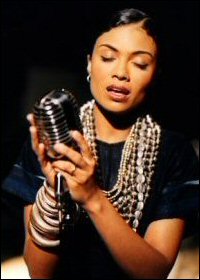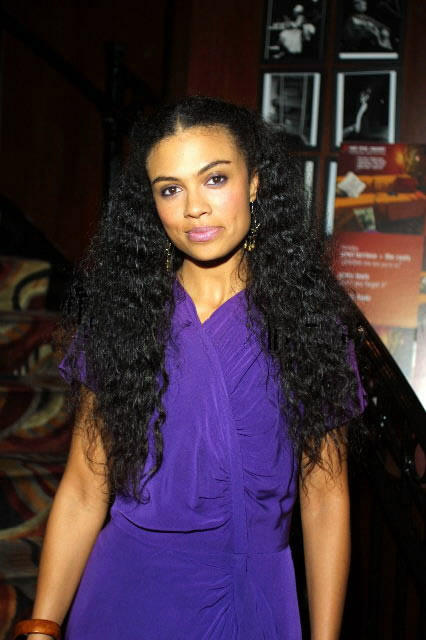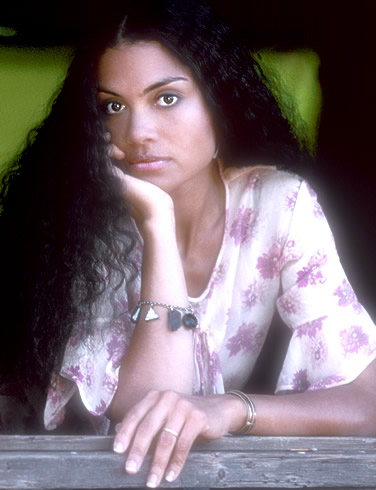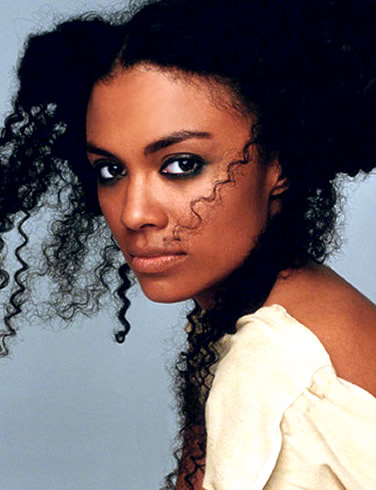AMEL LARRIEUX / “Try Your Wings”
Amel Larrieux first gained notoriety back in the mid-nineties as half of the neo-soul duo Groove Theory. Since then, Amel has released three more albums that are similar in style to her work with Groove Theory, but to my ears at least, much more nuanced and rich in their presentation. After the first of her post-Groove Theory albums, Infinite Possibilities, failed to produce any radio hits, Amel parted ways with Epic/Sony. I still don’t know for sure whether she was dropped by the label or chose to leave on her own. Either way, I was both surprised and pleased when Amel’s third release showed up on Blisslife, an independent label, instead of on another major label.
 Blisslife recently released Amel’s fifth album, Lovely Standards, and it is exactly what the title suggests it to be: a collection of pop/jazz standards. What I find intriguing about the album as a whole is that Amel sings the songs as if they’re pop songs. And of course, most of them originally were pop songs. It’s just that we’ve gotten used to hearing these songs in a jazz context. So ironically, Amel gives these songs a fresh reading by performing them the ‘old’ way.
When I first saw the track listing, I expected Amel to be showing off the range of her voice (including those famously off-the-charts high notes she’s capable of) while talented young instrumentalists did their best to show off their virtuosity as well. But along with her husband/producer Laru and pianist/arranger Yakir Ben-Hur, Amel took almost the opposite tack. Lovely Standards is subtle, tasteful and understated…almost to a fault. With the exception of the album-closer, Ellington’s “I Like The Sunrise,” the band never accelerates the tempo past a leisurely stroll and Amel’s voice never rises above a pleasant croon. Compared to the rest of Amel’s work, these are damn near lullabies.
Blisslife recently released Amel’s fifth album, Lovely Standards, and it is exactly what the title suggests it to be: a collection of pop/jazz standards. What I find intriguing about the album as a whole is that Amel sings the songs as if they’re pop songs. And of course, most of them originally were pop songs. It’s just that we’ve gotten used to hearing these songs in a jazz context. So ironically, Amel gives these songs a fresh reading by performing them the ‘old’ way.
When I first saw the track listing, I expected Amel to be showing off the range of her voice (including those famously off-the-charts high notes she’s capable of) while talented young instrumentalists did their best to show off their virtuosity as well. But along with her husband/producer Laru and pianist/arranger Yakir Ben-Hur, Amel took almost the opposite tack. Lovely Standards is subtle, tasteful and understated…almost to a fault. With the exception of the album-closer, Ellington’s “I Like The Sunrise,” the band never accelerates the tempo past a leisurely stroll and Amel’s voice never rises above a pleasant croon. Compared to the rest of Amel’s work, these are damn near lullabies.
 Of course, I mean that in a good way, but I wouldn’t be surprised if some of Amel’s existing fans actually are put to sleep by her new CD. It’s background music for people who hate background music. It’s the sort of thing that I only wish they played on elevators. It’s the kind of CD you can put on, then actually forget it’s playing. The catch is, you’ll also find yourself skipping back to track one to listen to it all over again.
—Mtume ya Salaam
Halfway home
Catholics have a name for a place between heaven and hell—and, no, it’s not earth. The midway point is called purgatory and that’s what this recording is. It’s not simply pop but then neither is it really jazz, and that’s both its strength and its weakness.
Of course, I mean that in a good way, but I wouldn’t be surprised if some of Amel’s existing fans actually are put to sleep by her new CD. It’s background music for people who hate background music. It’s the sort of thing that I only wish they played on elevators. It’s the kind of CD you can put on, then actually forget it’s playing. The catch is, you’ll also find yourself skipping back to track one to listen to it all over again.
—Mtume ya Salaam
Halfway home
Catholics have a name for a place between heaven and hell—and, no, it’s not earth. The midway point is called purgatory and that’s what this recording is. It’s not simply pop but then neither is it really jazz, and that’s both its strength and its weakness.
 On first listening, except for the acoustic guitar/voice duet of “The Shadow Of Your Smile,” this recording sounds like a supper club act—a tuxedoed jazz piano trio backing a fetching vocalist.
One of the deepest paradoxes of the genre known as jazz is that the majority of what jazzheads call standards were pop tunes that jazz players chose to use as the foundation for improvisation and investigation. What turns standards into jazz is how the songs are interpreted and performed. The weakness of this recording is that on most songs Ms. Larrieux chooses to take a pop approach. Except for Duke Ellington’s “I Like The Sunrise” and “Lucky To Be Me” Amel declines to take the deep plunge into jazz.
I kept wishing for more. You can feel that there’s a deep well of passion beneath the placid facade but Amel chooses not to plummet the depths. Nevertheless, although it’s a couple of steps to the right of the kind of jazz vocals I love, there’s still a bunch to admire about this effort, not the least of which is that, in an age of computer-generated instrumentation, Amel decided to buck the dominate sound and record in an all-acoustic format. This is one brave, brave recording.
In addition to its format, I also like what Amel does with her voice. Often she sounds like she singing at the edge of her range when actually she has a stronger and wider range than she is using. Again, except for the aforementioned “I Like The Sunrise” and “Lucky To Be Me,” every other song is understated, awash with sexy, seductive whispers.
It sounds like the engineers used a close-mic recording technique which enables us to clearly hear Amel’s micro-shifts in tone and timber. Close mic-ing also captures the intimacy of Amel’s airy sound: fragile, trembling, sotto-voiced tones; coy moments when she seems to reach for a particular note but only produces sighs and warm exhales.
On first listening, except for the acoustic guitar/voice duet of “The Shadow Of Your Smile,” this recording sounds like a supper club act—a tuxedoed jazz piano trio backing a fetching vocalist.
One of the deepest paradoxes of the genre known as jazz is that the majority of what jazzheads call standards were pop tunes that jazz players chose to use as the foundation for improvisation and investigation. What turns standards into jazz is how the songs are interpreted and performed. The weakness of this recording is that on most songs Ms. Larrieux chooses to take a pop approach. Except for Duke Ellington’s “I Like The Sunrise” and “Lucky To Be Me” Amel declines to take the deep plunge into jazz.
I kept wishing for more. You can feel that there’s a deep well of passion beneath the placid facade but Amel chooses not to plummet the depths. Nevertheless, although it’s a couple of steps to the right of the kind of jazz vocals I love, there’s still a bunch to admire about this effort, not the least of which is that, in an age of computer-generated instrumentation, Amel decided to buck the dominate sound and record in an all-acoustic format. This is one brave, brave recording.
In addition to its format, I also like what Amel does with her voice. Often she sounds like she singing at the edge of her range when actually she has a stronger and wider range than she is using. Again, except for the aforementioned “I Like The Sunrise” and “Lucky To Be Me,” every other song is understated, awash with sexy, seductive whispers.
It sounds like the engineers used a close-mic recording technique which enables us to clearly hear Amel’s micro-shifts in tone and timber. Close mic-ing also captures the intimacy of Amel’s airy sound: fragile, trembling, sotto-voiced tones; coy moments when she seems to reach for a particular note but only produces sighs and warm exhales.
 Paradoxically, part of reason the record works is because of Larrieux’s stunning physical beauty. Although her looks are not her sound per se, this is still the season of the attractive mulatto in the American music industry. (Amel’s mother is African-American, her father a Euro-American of French, English and Scottish descent.) Amel had the option of exploiting her beauty, that’s obvious, but she chose to take the far more difficult path of being a serious artist.
In a brief but revealing interview she said:
Paradoxically, part of reason the record works is because of Larrieux’s stunning physical beauty. Although her looks are not her sound per se, this is still the season of the attractive mulatto in the American music industry. (Amel’s mother is African-American, her father a Euro-American of French, English and Scottish descent.) Amel had the option of exploiting her beauty, that’s obvious, but she chose to take the far more difficult path of being a serious artist.
In a brief but revealing interview she said:
I would say the one surefire way to get to your own sound is to be oblivious to trends, or at least steer clear of them. I love live performance and improv, so I'm sure I've honed my singing skills and adopted a style of sorts by doing stuff like two sixty-minute sets a night, three nights in a row at smaller jazz venues. (Amel Larrieux interview)Here we have Lena Horne’s musical grandchild. As attractive as she is, Amel is more serious about her music than her looks. She is not interested in merely presenting herself as a sex object. Like Lena Horne, Amel Larrieux’s mix of physical beauty and social consciousness is a winning combination. None of Ms. Larrieux’s peers have produced anything as serious as this recording of Lovely Standards. On that basis alone Amel deserves both kudos and encouragement. As a pop recording this is near the top of the current offerings. As a jazz recording (measured against the high standards of predecessors such as Billie Holiday, Carmen McRae and more recently Dianne Reeves and Dee Dee Bridgewater), Amel has produced a very promising debut. —Kalamu ya Salaam Labels and notes Two quick things I wanted to add. First, Kalamu mentioned to me that he thinks Blisslife is Amel's and Laru's own label. I hope so. That'd make a good story even better. Second thing is, I want to agree with Kalamu about the close mic-ing and Amel's vocal range. More than once, I've seen Amel compared with Minnie Riperton because of the two singers' proficiency with extreme high notes. But over and over on this album (as Kalamu mentions in his comments), Amel misses high notes instead of hitting them. I kept wondering, did she have a sore throat that day? A cold? Or was she doing that on purpose? I really couldn't tell. Whatever the reason was, it actually doesn't hurt the songs. There are lots of great vocalists like Joan Armatrading, Jimi Hendrix and Sidsel Endresen who are unable to hit certain high notes, but sing them anyway. When their voices dissolve into that breathy rasping sound, it carries with it a certain emotional impact that clear, clean notes just don't have. Whether Amel was missing notes on this album on purpose or because of some circumstance beyond her control, in the end, I think it worked just the same. —Mtume ya Salaam
This entry was posted on Sunday, July 22nd, 2007 at 12:20 am and is filed under Contemporary. You can follow any responses to this entry through the RSS 2.0 feed. You can leave a response, or trackback from your own site.
6 Responses to “AMEL LARRIEUX / “Try Your Wings””
July 22nd, 2007 at 7:38 am
I’m glad you guys featured this as it has been generating a low buzz. I was excited to learn that Amel was going to do a album of standards because I’m first a fan of Amel and second a fan of Standards so the combo was perfect. As you two have both noted, I was a bit disappointed in the end product. You hit the nail on the head…too understated and leave you wanting for more to a fault. If you are going to take a risk and do an album of standards it should be outstanding. Queen Latifah did the same thing…she was able to create a new audience set but I was underwhelmed with the body of work. I think you have it right…great background music — a cafe, a dinner party — something of that sort but to sit down and put it on is the like sipping a cup of Sleepytime tea.
Mtume says:
I think I must’ve been too reserved in my original comments because I’m actually not underwhelmed by the album at all. I like it a lot. A whole lot. I was just saying that I’m aware that other Amel fans might be put to sleep by it. Not me though. I’m loving it.
July 22nd, 2007 at 12:37 pm
This really is lovely. It’s subtle and pretty. In a country where everything the media spews is so damn over the top, I appreciate something quiet, sincere, and well-crafted
Thanks for it!
one love,
Ekere
July 22nd, 2007 at 11:19 pm
Amel is currently out on tour and we caught her and her new band at Yoshi’s in Oakland a few weeks ago… she only sang 3 or 4 tracks from Lovely Standards and they were mixed in with all sorts from her repertoire. She would switch from neo-funk, to jazz scatting, to upbeat soul (and hip hop inflected at that) to old-fashioned nightclub torch singer. It was like a soulful gumbo.
I think that she really lets down her hair down when she performs live and that it was a deliberate policy while recording to be so controlled. The evidence: the notes she was hitting live were simply unbelievable. Thus we should consider the album a mere taste, the real hook is the live experience that she and Blisslife are shrewdly cultivating.
The Minnie Riperton comparison is apt both in terms of the range and the cry quality of the voice.
The close mic is very effective, if you listen closely to sunrise you’ll hear the kind of vibrato effect that made songs like Gills and tails (from the last album) so exciting to the ear. I’ve been listening to this album back to back with Abbey sings Abbey and they flow well together. Both albums are not the best of either artist yet both albums elicit a certain wonder at the possibilities of this music we love – and these are musicians’ musicians.
Her reputation live is as the queen of long endings and you would never guess it from the album. I Like the Sunrise and Lucky to Be Me are indeed the only tracks that hint at the kind of things that happen when she and the band stretch out.
But let me not go on, I am due for another pass at Amel Larrieux… Some fighting words to end: I know that Erykah Badu appreciation runs deep in this joint but right now no one is touching Amel.
July 23rd, 2007 at 11:14 am
Am I the only one who thinks the close-mic only accentuates some flaws? Don’t get me wrong, Amel is a great singer. It’s just that from a Jazz perspective, Diana Krall she ain’t. She does a decent job covering the songs, but her voice lacks fullness in some parts…especially using the close-mic technique. To me, in “Lucky To Be Me”, she spends the first half of the song trying to sound like someone else (Janita, or almost Sade). Towards the end, she sounds more like herself…at an exceptional level, i.e. Rounder tones. Kudos to her scatting ability and her high octaves.
It probably would be great to see her live, especially if she sounds better. The band is great though.
August 15th, 2007 at 6:37 am
for Amel Larrieux fans:
http://amel-larrieux-lovely-standards.info/
December 28th, 2007 at 2:04 am
I am one of Amel’s biggest fans. Every song on every album is an inspiration to me. I hope that she continues to express herself as SHE feels and only what SHE feels. Thank You For Blessing Us!
Leave a Reply
| top |